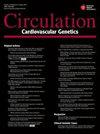Inflammatory Biomarkers Predict Heart Failure Severity and Prognosis in Patients With Heart Failure With Preserved Ejection Fraction: A Holistic Proteomic Approach
Q Medicine
引用次数: 106
Abstract
Background— Underlying mechanisms in heart failure (HF) with preserved ejection fraction remain unknown. We investigated cardiovascular plasma biomarkers in HF with preserved ejection fraction and their correlation to diastolic dysfunction, functional class, pathophysiological processes, and prognosis. Methods and Results— In 86 stable patients with HF and EF ≥45% in the Karolinska Rennes (KaRen) biomarker substudy, biomarkers were quantified by a multiplex immunoassay. Orthogonal projection to latent structures by partial least square analysis was performed on 87 biomarkers and 240 clinical variables, ranking biomarkers associated with New York Heart Association (NYHA) Functional class and the composite outcome (all-cause mortality and HF hospitalization). Biomarkers significantly correlated with outcome were analyzed by multivariable Cox regression and correlations with echocardiographic measurements performed. The orthogonal partial least square outcome-predicting biomarker pattern was run against the Ingenuity Pathway Analysis (IPA) database, containing annotated data from the public domain. The orthogonal partial least square analyses identified 32 biomarkers correlated with NYHA class and 28 predicting outcomes. Among outcome-predicting biomarkers, growth/differentiation factor-15 was the strongest and an additional 7 were also significant in Cox regression analyses when adjusted for age, sex, and N-terminal probrain natriuretic peptide: adrenomedullin (hazard ratio per log increase 2.53), agouti-related protein; (1.48), chitinase-3–like protein 1 (1.35), C–C motif chemokine 20 (1.35), fatty acid–binding protein (1.33), tumor necrosis factor receptor 1 (2.29), and TNF-related apoptosis-inducing ligand (0.34). Twenty-three of them correlated with diastolic dysfunction (E/e′) and 5 with left atrial volume index. The IPA suggested that increased inflammation, immune activation with decreased necrosis and apoptosis preceded poor outcome. Conclusions— In HF with preserved ejection fraction, novel biomarkers of inflammation predict HF severity and prognosis that may complement or even outperform traditional markers, such as N-terminal probrain natriuretic peptide. These findings lend support to a hypothesis implicating global systemic inflammation in HF with preserved ejection fraction. Clinical Trial Registration— URL: http://www.clinicaltrials.gov; Unique identifier: NCT00774709.炎症生物标志物预测射血分数保留的心力衰竭患者的心力衰竭严重程度和预后:一种整体蛋白质组学方法
背景-保留射血分数的心力衰竭(HF)的潜在机制尚不清楚。我们研究了保留射血分数的心衰患者的心血管血浆生物标志物及其与舒张功能障碍、功能分类、病理生理过程和预后的相关性。方法和结果-在卡罗林斯卡雷恩(KaRen)生物标志物亚研究中,86例HF和EF≥45%的稳定患者,生物标志物通过多重免疫分析法进行量化。通过偏最小二乘分析,对87个生物标志物和240个临床变量进行了潜在结构的正交投影,对与纽约心脏协会(NYHA)功能分类和综合结局(全因死亡率和心衰住院率)相关的生物标志物进行了排序。通过多变量Cox回归分析与预后显著相关的生物标志物,并与超声心动图测量结果进行相关性分析。正交偏最小二乘结果预测生物标志物模式在独创性途径分析(IPA)数据库中运行,该数据库包含来自公共领域的注释数据。正交偏最小二乘分析确定了32个与NYHA分类相关的生物标志物和28个预测结果。在预测结果的生物标志物中,生长/分化因子-15是最强的,另外7个在Cox回归分析中也具有显著性,当调整年龄、性别和n端脑钠肽前体时:肾上腺髓质素(每对数增加的风险比为2.53)、刺痛病相关蛋白;(1.48)、几丁质酶-3样蛋白1(1.35)、C-C基序趋化因子20(1.35)、脂肪酸结合蛋白(1.33)、肿瘤坏死因子受体1(2.29)和tnf相关的凋亡诱导配体(0.34)。其中23例与舒张功能不全(E/ E′)相关,5例与左房容积指数相关。IPA提示炎症、免疫激活增加,坏死和凋亡减少,预后较差。结论:在保留射血分数的HF中,新的炎症生物标志物可以预测HF的严重程度和预后,可能补充甚至优于传统标志物,如n端脑利钠肽前体。这些发现支持了一种假设,即心力衰竭患者存在全身性炎症并保留射血分数。临床试验注册-网址:http://www.clinicaltrials.gov;唯一标识符:NCT00774709。
本文章由计算机程序翻译,如有差异,请以英文原文为准。
求助全文
约1分钟内获得全文
求助全文
来源期刊

Circulation-Cardiovascular Genetics
CARDIAC & CARDIOVASCULAR SYSTEMS-GENETICS & HEREDITY
CiteScore
3.95
自引率
0.00%
发文量
0
期刊介绍:
Circulation: Genomic and Precision Medicine considers all types of original research articles, including studies conducted in human subjects, laboratory animals, in vitro, and in silico. Articles may include investigations of: clinical genetics as applied to the diagnosis and management of monogenic or oligogenic cardiovascular disorders; the molecular basis of complex cardiovascular disorders, including genome-wide association studies, exome and genome sequencing-based association studies, coding variant association studies, genetic linkage studies, epigenomics, transcriptomics, proteomics, metabolomics, and metagenomics; integration of electronic health record data or patient-generated data with any of the aforementioned approaches, including phenome-wide association studies, or with environmental or lifestyle factors; pharmacogenomics; regulation of gene expression; gene therapy and therapeutic genomic editing; systems biology approaches to the diagnosis and management of cardiovascular disorders; novel methods to perform any of the aforementioned studies; and novel applications of precision medicine. Above all, we seek studies with relevance to human cardiovascular biology and disease. Manuscripts are examined by the editorial staff and usually evaluated by expert reviewers assigned by the editors. Both clinical and basic articles will also be subject to statistical review, when appropriate. Provisional or final acceptance is based on originality, scientific content, and topical balance of the journal. Decisions are communicated by email, generally within six weeks. The editors will not discuss a decision about a manuscript over the phone. All rebuttals must be submitted in writing to the editorial office.
 求助内容:
求助内容: 应助结果提醒方式:
应助结果提醒方式:


